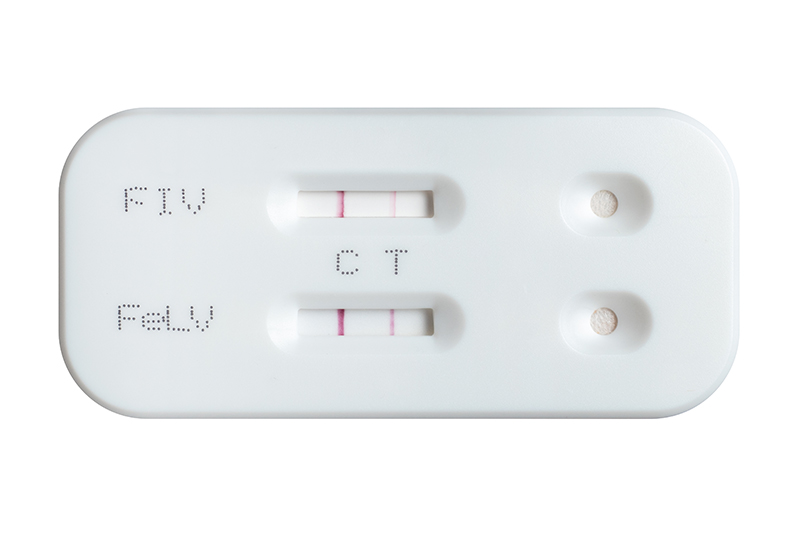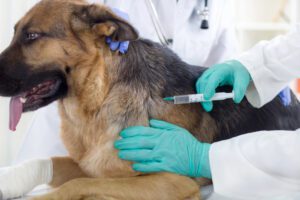Feline Leukemia Virus

What is Feline Leukemia?
Feline leukemia virus (FeLV) is a virus that infects cats. It was first discovered in cats with a form of leukemia (cancer of the white blood cells). FeLV can cause a variety of diseases in addition to leukemia.
How is it transmitted?
Felines can’t transmit FeLV to dogs or people. Cats contract the virus when they come into direct contact with infected bodily fluids; saliva, nasal secretions, blood, urine and feces. Otherwise healthy felines can spread FeLV during high-risk activities. Some cats become infected when grooming. Kittens may contract the illness when they drink milk from nursing mothers. Other transmissions occur when cats receive bites during a fight. Risks of environmental infections are low. The virus only lives a few hours outside after it leaves a cat’s body.
Risk Factors
Exposure to infected cats raises your cat’s risk of contracting FeLV, especially for kittens and young adult cats. Older cats are less likely to contract the infection, because resistance seems to increase with age. For indoor-only cats, the risk of contracting FeLV is very low. Cats in multi-cat households or in catteries are more at risk, especially if they share water and food dishes and litter boxes.
Symptoms
Cats with FeLV may not show any signs, even for years. Some of the more common symptoms of feline leukemia include:
- Anemia
- Lethargy
- Progressive weight loss
- Susceptibility to infection
- Persistent diarrhea
- Infections of the external ear and skin and poor coat condition
- Fever (seen in about 50 percent of cases)
- Wobbly, uncoordinated or drunken-appearing gait or movement
- Inflammation of the nose, the cornea, or the moist tissues of the eye
- Lymphoma (the most common FeLV-associated cancer)
- Fibrosarcoma (cancer that develops from fibrous tissue)
- Stomatitis – Oral disease that includes ulceration of gingiva
Diagnosing Feline Leukemia Virus
Your veterinarian can diagnose the disease by conducting a simple blood test called an ELISA, which identifies FeLV proteins in the blood. This test is highly sensitive and can identify cats with very early infections. It is important to remember that some cats will manage to clear the infection within a few months and will subsequently test negative. A second blood test, the IFA, detects the progressive phase of the infection, and cats with positive results for this test are unlikely to clear the virus. The IFA test is performed at a laboratory, rather than in your vet’s clinic. In general, cats that are IFA-positive have a poor long-term prognosis. If your cat is ill, your veterinarian will first rule out other infections such as bacterial, parasitic, viral or fungal. In addition, nonviral cancers need to be ruled out.
Is there any treatment for FeLV infection or disease?
There is currently no specific treatment for FeLV-infected cats. There is no treatment to eliminate the virus from the body. Most FeLV-infected cats will eventually die or require humane euthanasia due to diseases related to their infection. If your cat has no symptoms when he/she is diagnosed with FeLV, there is no treatment necessary apart from good at-home care. If your cat is ill, feline leukemia makes it difficult for the cat’s body to respond to treatment. Your veterinarian will prescribe medication to treat the symptoms. Your cat may be hospitalized for severe secondary infections, low red-blood cell count, weight loss with muscle loss, or other symptoms as your veterinarian sees fit. In these cases, he will be kept under hospital care until his condition stabilizes. Emergency treatment, such as blood transfusions, is sometimes required.
Prevention
Keeping your cat indoors and away from infected cats is a sure way to prevent them from contracting FeLV. In addition, vaccines can be given to cats at high risk of exposure, such as those who go outside or live in shelters or catteries. Only cats that test negative for FeLV should be vaccinated, and even those that have received the vaccine should be tested if there has been a possible exposure to the virus. The test should not be given before 30 days after the possible exposure. According to the American Association of Feline Practitioners, any cat that’s sick should be tested. That’s because there is a wide variety of health issues that can be associated with the virus. New cats or kittens over eight weeks of age should be tested for the virus before being introduced to a multi-cat household. Most veterinarians counsel against introducing a new cat into a household with a FeLV-positive cat, because they may be at risk for contracting the infection – even with vaccination. In addition, the stress of a newcomer may adversely affect the FeLV-positive cat.
Share This Post
Recent Posts
About Shallowford Animal Hospital
Shallowford Animal Hospital and The Pet Spa at Shallowford are dedicated to the exceptional, compassionate care your pet deserves. Pets hold a very special place in our families, and we treat yours like our own.



